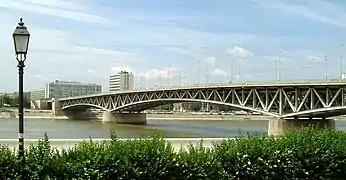Petőfi híd (Hungarian pronunciation: [ˈpɛtøːfi ˈhiːd]) or Petőfi Bridge (named after Sándor Petőfi, old name is Horthy Miklós Bridge, named after governor Miklós Horthy) is a bridge in Budapest, connecting Pest and Buda across the Danube. It is the second southernmost public bridge in Budapest.
Its two ends are:
- Boráros tér (southern end of Grand Boulevard and terminus of the Csepel HÉV)
- Goldmann György tér (next to the campuses of the Budapest University of Technology and Economics)
Budapest already made a proposal in the early 1900s to build the bridge, but the competent state bodies believed that a bridge in Óbuda was much more important. After the start of World War I., the idea was postponed, however, the bridge was still important for the townspeople.[1]
The bridge was built between 1933 and 1937,[2] according to the plans of Hubert Pál Álgyay. It is 514 m in length (along with the sections leading up) and 25.6 m in width. It was destroyed by the retreating German troops during the Second World War. Its rebuilt version was inaugurated in November 1952, when it also took on its new name, Petőfi Bridge.[3]
See also
References
- ↑ "Lovely Budapest". Archived from the original on 2019-08-29. Retrieved 2016-10-18.
- ↑ "Petőfi bridge - Budapest Bridges".
- ↑ "The Fascinating History of Petőfi Bridge". Hungarianconservative.com.
External links
- DBridges - Petőfi híd
- Photos of Budapest bridges
- Petöfi hid at Structurae
- Bridges of Budapest - Petofi Bridge
47°28′44″N 19°03′48″E / 47.47889°N 19.06333°E
